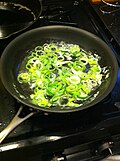Sautéing

Sautéing is a method of cooking that uses a small amount of oil or fat in a shallow pan over relatively high heat. Unlike pan-frying, which uses more oil and lower heat, sautéing is characterized by the use of high heat and the need to keep the food moving in the pan. The word comes from the French verb sauter, which means "to jump".
Technique[edit]
In sautéing, the food is usually cut into pieces or thinly sliced to ensure even cooking. The pan is preheated before adding the oil or fat, which should be hot enough to sear the food quickly. This method is often used for vegetables, meat, fish, and poultry.
Steps[edit]
1. **Preheat the Pan**: The pan should be heated over medium-high to high heat. 2. **Add Oil or Fat**: Once the pan is hot, add a small amount of oil or fat. Common choices include olive oil, butter, or vegetable oil. 3. **Add Food**: Place the food in the pan in a single layer to ensure even cooking. 4. **Keep it Moving**: Stir or toss the food frequently to prevent sticking and to ensure even browning. 5. **Cook Until Done**: Continue to cook until the food reaches the desired level of doneness.
Equipment[edit]
The primary piece of equipment for sautéing is a sauté pan, which has a wide, flat bottom and relatively low sides. This design allows for maximum contact between the food and the pan, facilitating even cooking and browning. A spatula or tongs are often used to turn and move the food.
Common Uses[edit]
Sautéing is a versatile technique used in many cuisines around the world. It is ideal for cooking vegetables, meat, fish, and poultry. Some common dishes that use sautéing include:
Advantages[edit]
- **Quick Cooking**: Sautéing is a fast cooking method, making it ideal for weeknight meals.
- **Flavor Development**: The high heat used in sautéing helps to develop rich, complex flavors through the Maillard reaction.
- **Versatility**: This technique can be used for a wide variety of foods and dishes.
Disadvantages[edit]
- **Risk of Burning**: The high heat used in sautéing can easily lead to burning if the food is not monitored closely.
- **Requires Attention**: Sautéing requires constant attention and frequent stirring or tossing to prevent sticking and ensure even cooking.
See Also[edit]
References[edit]
<references group="" responsive="1"></references>
External Links[edit]
Sautéing[edit]
-
Leek Sauté
-
Sauté Onions and Peppers
-
Baby Bella Mushrooms Being Sautéed
-
Tossing Sautéed Vegetables
-
Flambé in a Sauté Pan
Ad. Transform your life with W8MD's Budget GLP-1 injections from $75


W8MD offers a medical weight loss program to lose weight in Philadelphia. Our physician-supervised medical weight loss provides:
- Weight loss injections in NYC (generic and brand names):
- Zepbound / Mounjaro, Wegovy / Ozempic, Saxenda
- Most insurances accepted or discounted self-pay rates. We will obtain insurance prior authorizations if needed.
- Generic GLP1 weight loss injections from $75 for the starting dose.
- Also offer prescription weight loss medications including Phentermine, Qsymia, Diethylpropion, Contrave etc.
NYC weight loss doctor appointmentsNYC weight loss doctor appointments
Start your NYC weight loss journey today at our NYC medical weight loss and Philadelphia medical weight loss clinics.
- Call 718-946-5500 to lose weight in NYC or for medical weight loss in Philadelphia 215-676-2334.
- Tags:NYC medical weight loss, Philadelphia lose weight Zepbound NYC, Budget GLP1 weight loss injections, Wegovy Philadelphia, Wegovy NYC, Philadelphia medical weight loss, Brookly weight loss and Wegovy NYC
|
WikiMD's Wellness Encyclopedia |
| Let Food Be Thy Medicine Medicine Thy Food - Hippocrates |
Medical Disclaimer: WikiMD is not a substitute for professional medical advice. The information on WikiMD is provided as an information resource only, may be incorrect, outdated or misleading, and is not to be used or relied on for any diagnostic or treatment purposes. Please consult your health care provider before making any healthcare decisions or for guidance about a specific medical condition. WikiMD expressly disclaims responsibility, and shall have no liability, for any damages, loss, injury, or liability whatsoever suffered as a result of your reliance on the information contained in this site. By visiting this site you agree to the foregoing terms and conditions, which may from time to time be changed or supplemented by WikiMD. If you do not agree to the foregoing terms and conditions, you should not enter or use this site. See full disclaimer.
Credits:Most images are courtesy of Wikimedia commons, and templates, categories Wikipedia, licensed under CC BY SA or similar.
Translate this page: - East Asian
中文,
日本,
한국어,
South Asian
हिन्दी,
தமிழ்,
తెలుగు,
Urdu,
ಕನ್ನಡ,
Southeast Asian
Indonesian,
Vietnamese,
Thai,
မြန်မာဘာသာ,
বাংলা
European
español,
Deutsch,
français,
Greek,
português do Brasil,
polski,
română,
русский,
Nederlands,
norsk,
svenska,
suomi,
Italian
Middle Eastern & African
عربى,
Turkish,
Persian,
Hebrew,
Afrikaans,
isiZulu,
Kiswahili,
Other
Bulgarian,
Hungarian,
Czech,
Swedish,
മലയാളം,
मराठी,
ਪੰਜਾਬੀ,
ગુજરાતી,
Portuguese,
Ukrainian





